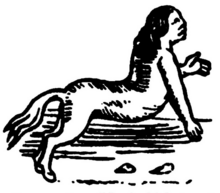| Revision as of 00:00, 30 January 2008 editLeolaursen (talk | contribs)Rollbackers12,919 editsm Categorizing article - You can help!← Previous edit | Latest revision as of 21:26, 12 January 2025 edit undo2600:1016:b041:31b:0:30:14a5:8001 (talk) Added short descriptionTags: Mobile edit Mobile app edit Android app edit App description add | ||
| (120 intermediate revisions by 58 users not shown) | |||
| Line 1: | Line 1: | ||
| {{Short description|Mythical Creature}} | |||
| {{unreferenced|date=December 2007}} | |||
| ] | |||
| In ], '''Ipotane'''s were a race of half-horse, half-humans, unlike the ]s, who were half-goat. | |||
| '''Ipotanes''' or '''hippotaynes''' are mythical creatures. They are usually depicted as being half-human half-horse creatures much different from the ]s. Although sometimes attributed to ], the term appears to have originated at a much later date, and without a definite description; they are first mentioned in ]'s fourteenth-century ''Travels''. Ipotanes appear in modern works of the ]. | |||
| ==John de Mandeville== | |||
| The typical Ipotane looked overall human, but had the legs, hindquarters, tail, and ears of a horse. However, some had humanlike rather than horselike legs (compare with early ], whose front legs were often humanlike). | |||
| In his 1356 travelogue, ''The Travels of Sir John Mandeville'',<ref>Charles Knight, ''Charles Knight's Popular History of England'', vol. 2, p. 13, London: Bradbury, Evans, & Company, 1862–67 {{oclc|942643783}}.</ref> the author reports the existence of a violent race of ''ipotanes'', found in Bacharie (]). | |||
| {{quote|...ben many Ipotanes that dwellen sometime in the water and sometime on the land; and thei ben half men and half hors and thei eten men when thei may take him|Wyken and Worde, 1499.<ref name="Vinycomb">John Vinycomb, ''Fictitious & Symbolic Creatures in Art'', p. 144, Gale Research Company, 1906 {{ISBN|0810331470}}.</ref>}} More recent editions of Mandeville's work use various spellings; ''hippotaynes'' (Macmillan, 1900),<ref>Sir John Mandeville, A.W. Pollard (ed), ''The Travels Of Sir John Mandeville'', p. 177, London: Macmillan & Co., 1900 {{oclc|1268064505}}</ref> ''hippopotami'' (Penguin, 1983).<ref>Sir John Mandeville, C.W.R.D. Pollard (trans), ''The Travels Of Sir John Mandeville'', p. 167, Penguin, 1983 {{oclc|1261243004}}.</ref> | |||
| ==Description== | |||
| {{greek-myth-stub}} | |||
| The word "ipotane" appears to be derived from the Greek {{lang|grc|ιππότης}} ({{lang|grc-Latn|hippotes}}), "a knight", which itself is derived from {{lang|grc|ίππος}} ({{lang|grc-Latn|hippos}}), "a horse".<ref>Henry George Liddell, Robert Scott, ''A Greek-English Lexicon'', , Oxford: Clarendon Press, 1890 {{oclc|493157397}}.</ref> Mandeville's description is not clearly distinguishable from that of a ], and some depictions use the term synonymously.<ref name="Vinycomb"/> Some depictions show ipotanes with a ] body and a ]'s head. Other depictions have them as humans with the hindquarters of a horse. | |||
| ] | |||
| ==Modern literature== | |||
| Despite their similarity to centaurs, ipotanes are not mentioned in the corpus of Greek and Roman literature. However, they appear in modern works of fantasy literature, in which they are depicted with various combinations of horse-like and human features.<ref>{{multiref|For example,|Nancy A. Collins, ''Right Hand Magic: A Novel of Golgotham'', Penguin, 2010 {{ISBN|1101445777}}|Amanda Bouchet, ''A Promise of Fire'', Hachette UK, 2016 {{ISBN|0349412537}}.}}</ref> | |||
| ==See also== | |||
| * ], Scottish folklore | |||
| * ], Greek myth | |||
| * ], fictional character | |||
| ==References== | |||
| {{reflist}} | |||
| ] | |||
| ] | |||
Latest revision as of 21:26, 12 January 2025
Mythical Creature
Ipotanes or hippotaynes are mythical creatures. They are usually depicted as being half-human half-horse creatures much different from the centaurs. Although sometimes attributed to Greek mythology, the term appears to have originated at a much later date, and without a definite description; they are first mentioned in John de Mandeville's fourteenth-century Travels. Ipotanes appear in modern works of the fantasy genre.
John de Mandeville
In his 1356 travelogue, The Travels of Sir John Mandeville, the author reports the existence of a violent race of ipotanes, found in Bacharie (Bactria).
...ben many Ipotanes that dwellen sometime in the water and sometime on the land; and thei ben half men and half hors and thei eten men when thei may take him
— Wyken and Worde, 1499.
More recent editions of Mandeville's work use various spellings; hippotaynes (Macmillan, 1900), hippopotami (Penguin, 1983).
Description
The word "ipotane" appears to be derived from the Greek ιππότης (hippotes), "a knight", which itself is derived from ίππος (hippos), "a horse". Mandeville's description is not clearly distinguishable from that of a centaur, and some depictions use the term synonymously. Some depictions show ipotanes with a human body and a horse's head. Other depictions have them as humans with the hindquarters of a horse.
Modern literature
Despite their similarity to centaurs, ipotanes are not mentioned in the corpus of Greek and Roman literature. However, they appear in modern works of fantasy literature, in which they are depicted with various combinations of horse-like and human features.
See also
- Glaistig, Scottish folklore
- Hippopodes, Greek myth
- BoJack Horseman, fictional character
References
- Charles Knight, Charles Knight's Popular History of England, vol. 2, p. 13, London: Bradbury, Evans, & Company, 1862–67 OCLC 942643783.
- ^ John Vinycomb, Fictitious & Symbolic Creatures in Art, p. 144, Gale Research Company, 1906 ISBN 0810331470.
- Sir John Mandeville, A.W. Pollard (ed), The Travels Of Sir John Mandeville, p. 177, London: Macmillan & Co., 1900 OCLC 1268064505
- Sir John Mandeville, C.W.R.D. Pollard (trans), The Travels Of Sir John Mandeville, p. 167, Penguin, 1983 OCLC 1261243004.
- Henry George Liddell, Robert Scott, A Greek-English Lexicon, p. 708, Oxford: Clarendon Press, 1890 OCLC 493157397.
-
- For example,
- Nancy A. Collins, Right Hand Magic: A Novel of Golgotham, Penguin, 2010 ISBN 1101445777
- Amanda Bouchet, A Promise of Fire, Hachette UK, 2016 ISBN 0349412537.